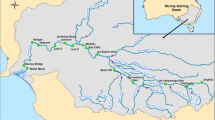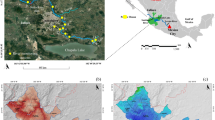Abstract
In 1940, the tidal Delaware River was “one of the most grossly polluted areas in the United States.” During the 1950s, water quality was so poor along the river at Philadelphia that zero oxygen levels prevented migration of American shad leading to near extirpation of the species. Since then, water quality in the Delaware Basin has improved with implementation of the 1961 Delaware River Basin Compact and 1970s Federal Clean Water Act Amendments. At 15 gages along the Delaware River and major tributaries between 1980 and 2005, water quality for dissolved oxygen, phosphorus, nitrogen, and sediment improved at 39%, remained constant at 51%, and degraded at 10% of the stations. Since 1980, improved water-quality stations outnumbered degraded stations by a 4 to 1 margin. Water quality remains good in the nontidal river above Trenton and, while improved, remains fair to poor for phosphorus and nitrogen in the tidal estuary near Philadelphia and in the Lehigh and Schuylkill tributaries. Water quality is good in heavily forested watersheds (>50%) and poor in highly cultivated watersheds. Water quality recovery in the Delaware Basin is coincident with implementation of environmental laws enacted in the 1960s and 1970s and is congruent with return of striped bass, shad, blue crab, and bald eagle populations.
Similar content being viewed by others
References
Albert, R. C. (1988). The historical context of water quality management for the Delaware Estuary. Estuaries, 11(2), 99–107.
Albert, R. C. (1991). Human use: Pollution. The Delaware Estuary: Rediscovering a forgotten resource (144 pp). Newark, Delaware: University of Delaware Sea Grant College Program.
Associated Press (2007). Bald eagle nest found in Philadelphia. Philadelphia Inquirer, March 17, 2007.
Atlantic States Marine Fisheries Commission (2008). Public information document for amendment 3 to the interstate fishery management plan for shad and river herring.
Cech, T. V. (2003). Principles of water resources history, development, management and policy (446 pp.). New York: Wiley.
Chittendon, M. E. (1971). Status of the striped bass, Morone saxatilis, in the Delaware River. Chesapeake Science, 12(3), 131–136.
Chittendon, M. E. (1974). Trends in the abundance of the American shad, Alosa sapidissima, in the Delaware River basin. Chesapeake Science, 15(2), 96–103.
Crockett, C. S. (2002). Delaware River source water assessment. Philadelphia, Pennsylvania: Philadelphia Water Department.
Dale, F. (1996). Delaware diary: Episodes in the life of a river (220 pp). New Brunswick, New Jersey: Rutgers University Press.
Delaware Department of Natural Resources and Environmental Control (1996). Preliminary assessment of water quality data for the Christina Basin. Dover: Delaware Department of Natural Resources and Environmental Control.
Delaware Department of Natural Resources and Environmental Control (2004). State of Delaware surface water quality standards, amended July 11, 2004.
Delaware Department of Natural Resources and Environmental Control (2007). State of Delaware 2006 combined watershed assessment report (305(b)) and Determination for the Clean Water Act Section 303(d) list of waters needing TMDLs. Dover: Delaware Department of Natural Resources and Environmental Control.
Delaware Estuary Program (1996). Discover its secrets: A management plan for the Delaware Estuary (148 pp.).
Delaware River Basin Commission (1975). Water management of the Delaware River basin. West Trenton: Delaware River Basin Commission.
Delaware River Basin Commission (1981). The Delaware River basin: The final report and environmental impact statement of the level B study. West Trenton: Delaware River Basin Commission.
Delaware River Basin Commission (2004). Water resources plan for the Delaware River basin. West Trenton: Delaware River Basin Commission.
Delaware River Basin Commission (2006). Administrative manual part III water quality regulations, 188 CFR part 410 with amendments through September 27, 2006.
Delaware River Basin Commission (2008a). State of the Delaware River basin report. West Trenton: Delaware River Basin Commission.
Delaware River Basin Commission (2008b). Delaware River and Bay integrated list water quality assessment. West Trenton: Delaware River Basin Commission.
Helsel, D. R., & Hirsch, R. M. (2002). Statistical methods in water wesources, chapter A3, techniques of water-resources investigations of the United States Geological Survey (510 pp.). Book 4, hydrologic analysis and interpretation.
Helsel, D. R., Mueller, D. K., & Slack, J. R. (2005). Computer program for the Kendall family of trend tests (4 pp.). Scientific investigations report 2005–5275. U.S. Geological Survey.
Hirsch, R. M., Slack, J. R., & Smith, R. A. (1982). Techniques of trend analysis for monthly water quality data. Water Resources Research, 18(6), 107–121.
Interlandi, S. J., & Crockett, C. S. (2003). Recent water quality trends in the Schuylkill River, Pennsylvania, USA: A preliminary assessment of the relative influences of climate, river discharge, and suburban development. Water Research, 37, 1737–1748.
Interstate Commission on the Delaware River Basin (1940). The Delaware River basin physical facts. Philadelphia: Interstate Commission on the Delaware River Basin.
Kahn, D. M., Zimmerman, M. C., & Murphy, G. (2006). Delaware’s 2006 striped bass harvest and compliance report to the ASMFC. Dover, Delaware: Delaware Division of Fish and Wildlife.
Kauffman, G., Belden, A., Homsey, A., Porter, M., Zarnadze, A., Ehrenfeld, J., et al. (2008). Technical summary: State of the Delaware River basin report (195 pp.). Prepared by University of Delaware, Cornell University, Rutgers University, and Pennsylvania State University. Submitted to Delaware River Basin Commission and Partnership for the Delaware Estuary.
Lanfear, K. J., & Alexander, R. B. (1990). Methodology to derive water-quality trends for use by the national water summary program of the U.S. Geological Survey (10 pp.). U.S. Geological Survey open-file report 90–359.
Lebo, M. E., & Sharp, J. H. (1993). Distribution of phosphorus along the Delaware, an urbanized coastal plain estuary. Estuaries and Coasts, 16(2), 290–301.
Litke, D. W. (1999). Review of phosphorus control measures in the United States and their effects on water quality (38 pp.). U.S. Geological Survey water-resources investigations report 99–4007.
New Jersey Department of Environmental Protection (2004). Fresh water pollution: Chemical and physical parameters. New Jersey 2004 integrated water monitoring and assessment report.
New Jersey Department of Environmental Protection (2006a). Surface water quality standards, effective April 17, 1998. Amended October 16, 2006.
New Jersey Department of Environmental Protection (2006b). Investigations and management of anadromous fisheries performance report grant: F-48R-19. Division of Fish, Game and Wildlife.
New York State Department of Environmental Conservation (1999). Water quality regulations, surface water and groundwater classifications and standards. Amended August 4, 1999.
Partnership for the Delaware Estuary (2002). The Delaware Estuary: Join the rediscovery, 2002 state of the estuary report (20 pp.).
Partnership for the Delaware Estuary (2008). State of the Delaware Estuary (36 pp.). PDE report no. 08–01. Wilmington, Delaware.
Pennsylvania Department of Environmental Protection (2005). Surface water quality trends along Pennsylvania streams, addendum A.
Pennsylvania Department of Environmental Resources (2007). Chapter 93. Water quality standards. March 2007.
Raney, E. C. (1952). The life history of the striped bass, roccus saxatilis (Walbaum). Bull Bingham Oceanographic Collection, 14, 5–97.
Reif, A. G. (2002). Assessment of stream conditions and trends in biological and water-chemistry data from selected streams in Chester County, Pennsylvania, 1981–97 (75 pp.). Water-resources investigations report 02–4242. U.S. Geological Survey.
Sharp, J. H. (2010). Estuarine oxygen dynamics: What can we learn about hypoxia from long-time records in the Delaware Estuary? Limnology and Oceanography, 55(2), 535–548.
Smith, J. G., Haber, R. A., Kaplovsky, A. J., & Simpson, C. O. (1959). State of Delaware intrastate water resources survey (pp. 1–1 to 29–11). Wilmington, Delaware. William N. Cann, Inc.
Sutton, C. C., O’Herron, J. C., II, & Zappalorti, R. T. (1996). The scientific characterization of the Delaware Estuary (200 pp.). Delaware Estuary Program.
Thomann, R. V. (1972). The Delaware River—a study in water quality management. In R. T. Oglesby, C. A. Carlson, J. A. McCann (Eds.), River ecology and man (456 pp.). New York: Academic.
Town, D. A. (2001). Historical trends and concentrations of fecal coliform bacteria in the Brandywine Creek basin, Chester County, Pennsylvania (46 pp.). Water-resources investigations report 01 - 4026. U. S. Geological Survey.
United States Environmental Protection Agency (2000a). Progress in water quality: An evaluation of the national investment in municipal wastewater treatment, chapter 7: Delaware Estuary case study (pp. 7–1–26).
United States Environmental Protection Agency (2000b). Ambient water quality criteria recommendations, information supporting the development of state and tribal nutrient criteria, rivers and streams in nutrient ecoregion XIV (20 pp.). EPA 822-B-00–02.
United States Geological Survey (2004). Water quality in the Delaware River basin, Pennsylvania, New Jersey, New York, and Delaware, 1998–2001 (48 pp.). USGS circular 1227. National Water-Quality Assessment Program.
Weisberg, S. B., Himchak, P., Baum, T., Wilson, H. T., & Allen, R. (1996). Temporal trends in abundance of fish in the tidal Delaware River. Estuaries, 19(3), 723–729.
Wildlands Conservancy (2003). The state of the Lehigh River report. Emmaus: Wildlands Conservancy.
Author information
Authors and Affiliations
Corresponding author
Rights and permissions
About this article
Cite this article
Kauffman, G.J., Homsey, A.R., Belden, A.C. et al. Water quality trends in the Delaware River Basin (USA) from 1980 to 2005. Environ Monit Assess 177, 193–225 (2011). https://doi.org/10.1007/s10661-010-1628-8
Received:
Accepted:
Published:
Issue Date:
DOI: https://doi.org/10.1007/s10661-010-1628-8




